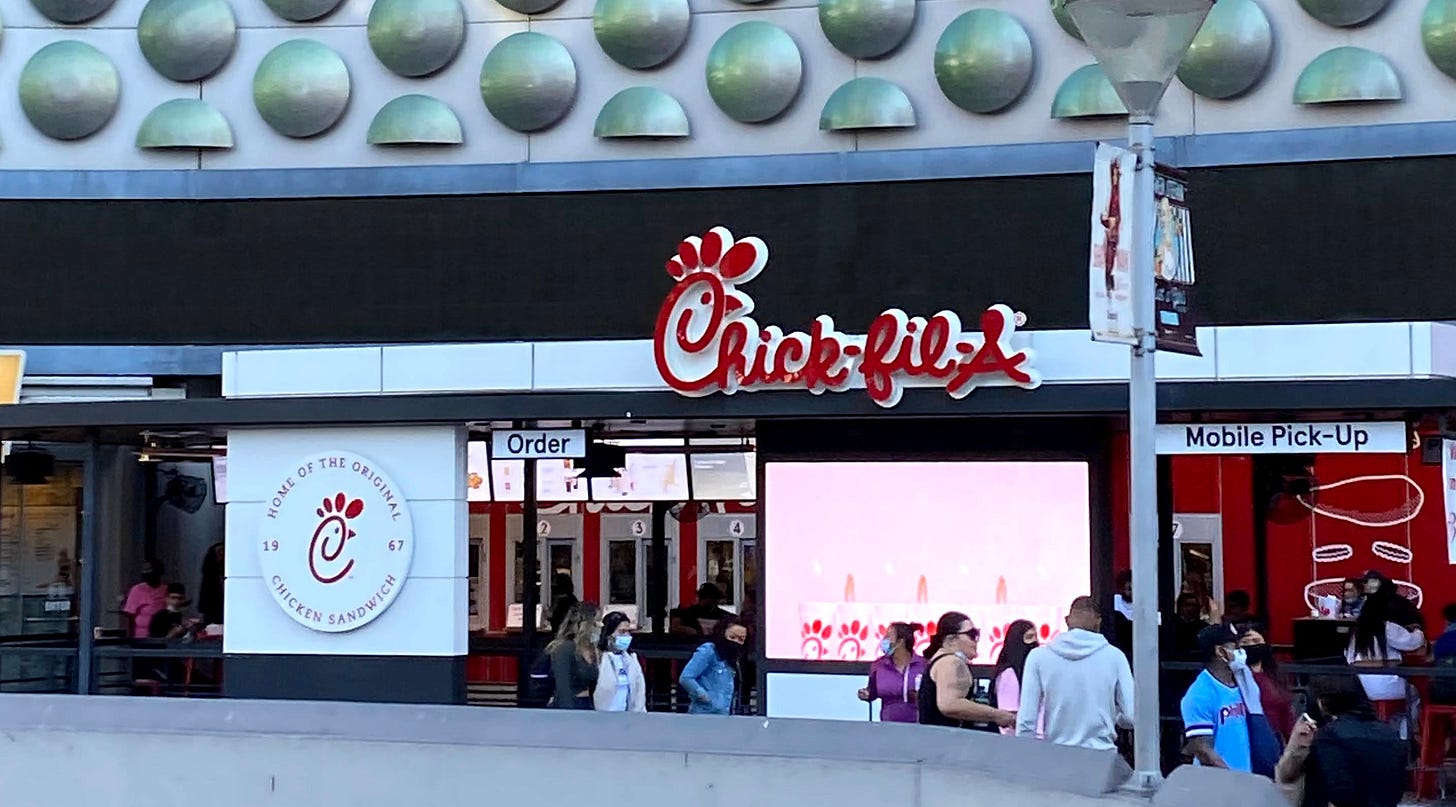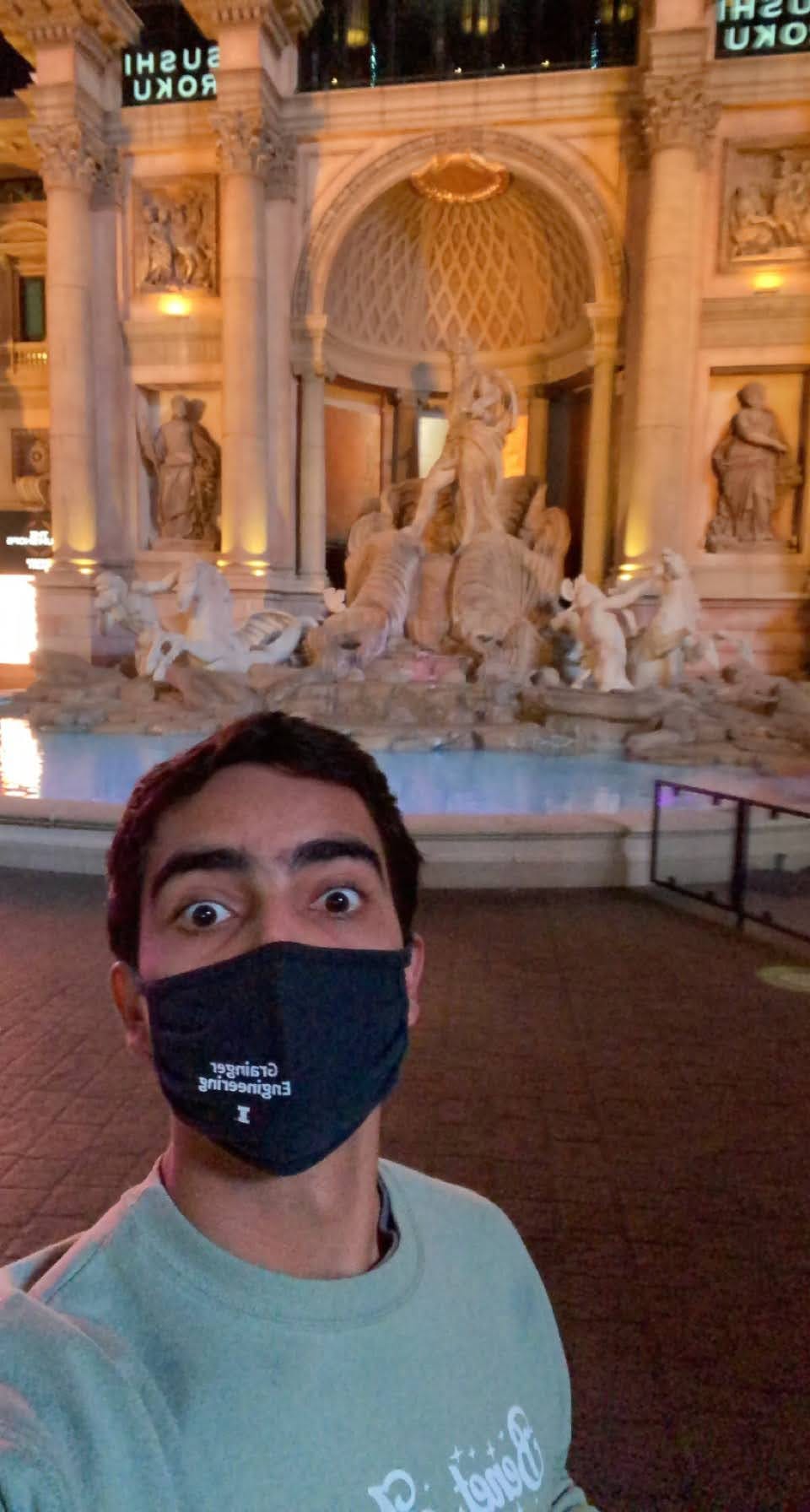Hey everyone,
Last day of the month and stoked to start the third month of the year!
So a couple of months ago, I went to the only city in the world where Chick-fil-A is open on Sundays. Wait, what? Open on Sundays? It must be a sinful city, then.
That city is Las Vegas. A random city in the middle of nowhere has not only given rise to the normalization of unhealthy trends (i.e. messed up stuff) but also the rise of the copy-paste culture.
📝This week’s essay is about how I witnessed the greatest sin I’ve ever seen, and it wasn’t gambling, drugs, or prostitution.
The Las Vegas Deadly Sin
If you prefer, you can read this essay on my website.
When my high school economics teacher would tell us a “spicy story,” he would remind us, “What Happens in Vegas, Stays in Vegas.”
Recently, I went to Las Vegas, and what I saw cannot stay there. I’m afraid we’ve been complacent and unimaginative when creating the largest American city founded in the 20th century [1].
I witnessed the greatest sin I’ve ever seen, and it wasn’t gambling, drugs, or prostitution.
“Thou shalt not covet thy neighbor’s goods.”
Whether or not you're religious, the 10th commandment serves to remind us that wanting what other people have or want will cause us to fall into the trap of competition, neglecting the pioneering American spirit.
Las Vegas became the greatest copycat place in the world. The epicenter of globalization and a place where a copy-paste culture surged.
I don’t think Las Vegas purposely tried to be like this, instead, it may have pushed the city to compete and copy others. They looked for answers by replicating other cities, instead of designing and creating a city no one can compete with. For instance, the mini Eiffel tower in Las Vegas is merely one of the 50 copies or iterations in the world.
Let’s say the Entertainment Capital of the World was pushed to compete with others.
But who forced Las Vegas to be a city of forgery? A possible explanation could be the slowdown of economic growth (aka the stagnation of growth).
What I saw in Las Vegas[2] is correlated to the stagnation hypothesis. But what is this hypothesis about?
The stagnation hypothesis suggests a significant slowdown in scientific, technological, and economic progress since about the 1970s.
And America has been no exception.
The United States used to be the place where we created, developed, and invented technology. Then, we could afford to borrow it, sell it, or let others copy it. But then, we did what others used to do, copy. If we all copy each other, little or no progress is made.
We need the type of countries and individuals who refuse to emulate others [2], build from scratch, and want to push the “innovation limits” forward.
But the world doesn’t have to be stagnant and slow. We can fix this.
The economist Tyler Cowen, one of the biggest proponents of the stagnation hypothesis, believes there’s an objectively right answer about what we should do or what we should not do to advance progress[3].
Before the rate of American progress began to stagnate, some people knew this was coming, such as Derek J. de Solla Price, and Vannevar Bush. Bush wrote a report to the president called, “Science The Endless Frontier [4],” in which he attempted to keep science funding after WWII. He wanted the government to invest with no thought of return because by pumping money into science, it will trickle down to the economy. Bush’s main message was to give scientists the freedom to pursue their curiosity wherever it might lead, ultimately leading to growth, security, and prosperity.
My friends, science seems to be our gateway to progress. Why? I’ll let Vannevar Bush reply, “This essential, new knowledge can be obtained only through basic scientific research [5].” Then, he explained why we need scientific progress, “But without scientific progress no amount of achievement in other directions can insure our health, prosperity, and security as a nation in the modern world [6].”
A Copy of a Simulated Reality
When you go to Las Vegas, a million forces are getting your attention, this is no coincidence. This is part of the phases of transformation that Las Vegas has gone through, which also explains the homogeneity in its architecture.
Stefan Johannes Al wrote “The Strip: Las Vegas and the Symbolic Destruction of Spectacle [7],” in which he explained how there lies a process of symbolic destruction behind four-building booms. These constant shifts in architecture and building booms create zero-sum games because each new resort devalues the older resorts even further. No wonder why the buildings in Las Vegas have little durations.
He explains that in one of the shifts in architecture, resorts began copying others. Stefan writes, "There is a shift from architecture based on fantasy to architecture based on simulation; resorts became idealized replicas of other places."
They didn’t become copycats for no reason, and Stefan explains:
Those resorts were replicas of other places; specifically, they evoked places of money, history, and culture, in order to appeal to an older and wealthier crowd, and they demoted the Disney model to cheap and childish.
In short, the Strip moved from the 21 spectacle of fantasy to chic urbanity, from the spectacle of Disney-like fantasy to the spectacle of simulated reality.
Creating a new, unique building (or resort) takes more energy, creativity, and time for people to get used to and understand the new architecture. Instead, what’s easier is to copy other known places with existing spots in our memory and emotions.
If using this model of mimicking others so it’s easier to get more customers. Why bother? Why even put the extra effort to create buildings like never before? Why? Why? Why?
From an economic and short-term perspective, this makes no sense. But if we care about the long-term, we have to do what's hard.
Because THEY ARE HARD
We went from creating original cities with unique and different architecture to creating fake copies of other places in the world. Even if the other cities in the U.S. weren’t completely original, they had a different spin, a new iteration.
Las Vegas is an example of the current state and current economic growth of the U.S. But don’t you forget that the United States of America is the best country in the world. We cannot copy others. We copy, we lose our leadership.
We need to get back to doing hard things with the attitude of actually wanting to win, and conquering new frontiers. JFK inspired us with this mentality to see and accomplish the impossible [8]. Let’s remind his speech:
But why, some say, the moon? Why choose this as our goal? And they may well ask why climb the highest mountain? Why, 35 years ago, fly the Atlantic? Why does Rice play Texas?
We choose to go to the moon. We choose to go to the moon in this decade and do the other things, not because they are easy, but because they are hard, because that goal will serve to organize and measure the best of our energies and skills, because that challenge is one that we are willing to accept, one we are unwilling to postpone, and one which we intend to win, and the others, too.
You can replace “the moon,” with any other incredibly hard ambitious goal such as curing cancer, living forever, flying cars, artificial general intelligence, and, of course, going to Mars.
This is the country where we go from nothing to something. This is the country that needs to stop copying and start creating, developing, and inventing. This is the country that needs to be the number one science advocate. This is the country of the land of opportunity. This is the country that values our freedom to pursue new, innovative ideas. This is the country where we do the hard things first.
THIS IS THE AMERICA I WANT.
———
Notes here.
Thanks to Tyler Cowen for reading drafts of this essay.
Curiosities on Las Vegas, baby! 🎰👯♀️💸
1. Largest City Founded in the 20th Century
What the???
A city in the middle of nowhere where few good things happen was the largest city of a century.
On a percentage basis, Las Vegas and Clark County experienced incredibly high growth rates starting in the 1930s and lasting until the late 2000s recession.By 2000, Las Vegas was the largest city founded in the 20th century.
2. Behind Reinventions Lies Symbolic Destruction
Quotes below from The Strip: Las Vegas and the Symbolic Destruction of Spectacle by Stefan Johannes Al
Over the past 70 years, various actors have dramatically reconfigured the Las Vegas Strip in many forms. I claim that behind the Strip’s “reinventions” lies a process of symbolic destruction.
Throughout Las Vegas’ growth, there have been periods of construction/renovation. and upgrades. These have been theorized as “suburbanization, corporatization, Disneyfication, and global branding.”
Then, Stefan Johannes Al explains how each of these construction eras can be explained using paradigms.
Each building boom either conforms to a single paradigm or witnesses a paradigm shift halfway: these paradigms have been theorized as Wild West, Los Angeles Cool, Pop City, Corporate Modern, Disneyland, Sim City, and Starchitecture.

If you want to ever want to experience what it’d feel like to be in the simulation, Las Vegas is the place as it creates a fully immersive experience that lures you to stay by having addictive experiences to keep you inside.
3. Sometimes More Real
I’ve been fortunate enough to have seen some of the real, original places/art that Las Vegas mimics.
I don’t like how they’re copying other people but I gotta say that many of the fake places found in Las Vegas look more real than the original ones.
“Goodbye reality, hello Vegas.”
What did you think of Las Vegas? Have you personally gone there? Let me know what you think by replying to this email or leaving a comment below.
or
See you next Sunday,
Juan David Campolargo







